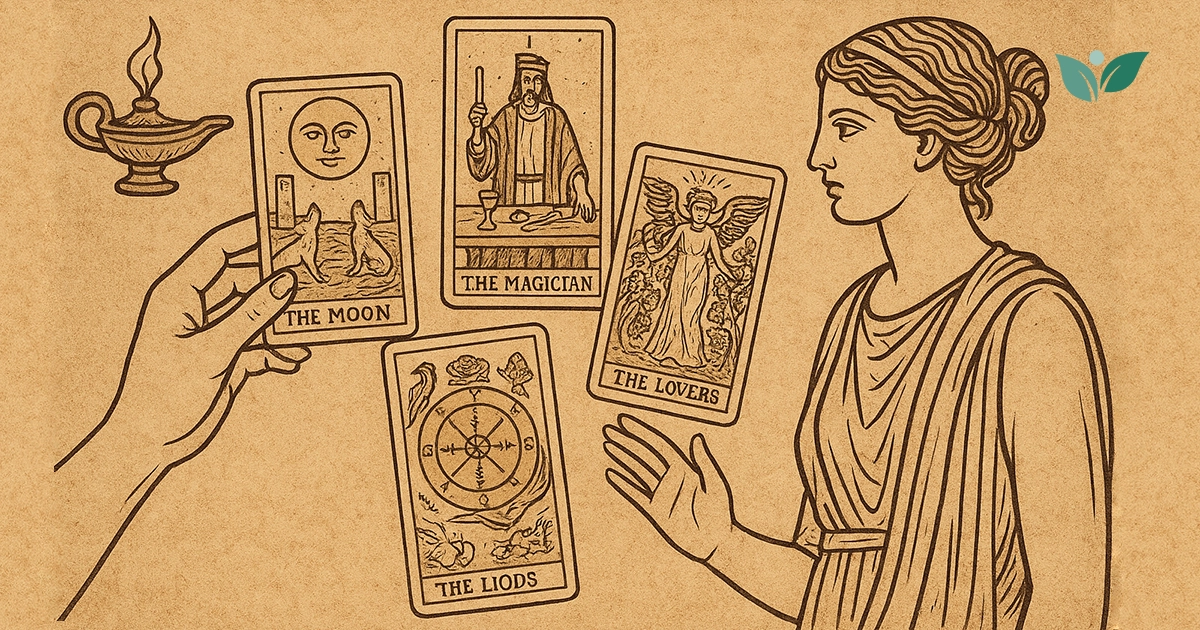Tarot readings are among the most fascinating and misunderstood practices in the world of spirituality and self-discovery. For some, tarot conjures images of candlelit fortune-telling parlors and mysterious psychics shuffling cards to reveal one’s future. For others, tarot is a sacred spiritual practice, a way of connecting with intuition, subconscious wisdom, and life’s hidden patterns.
But what exactly are tarot readings? Do they predict the future, or are they simply symbolic reflections of our inner world? And why do so many people—ranging from spiritual seekers to psychologists and even business leaders—turn to tarot as a tool for guidance?
At its core, a tarot reading is the act of drawing cards from a tarot deck and interpreting their symbolism in response to a question, concern, or situation. Each card represents an archetype, an energy, or a theme that, when placed in a spread, creates a story that provides insight into one’s present circumstances and possible paths forward.
Far from being a rigid fortune-telling method, tarot is a mirror of the self. It does not lock you into destiny but instead highlights choices, patterns, and perspectives. A tarot reading helps you ask better questions, see possibilities more clearly, and connect more deeply to your inner guidance.
Table of Contents
- What Are Tarot Readings?
- A Brief History of Tarot Readings
- How Tarot Readings Work
- The Structure of a Tarot Deck
- Major Arcana (22 cards explained)
- Minor Arcana (56 cards explained by suit)
- The Purpose of Tarot Readings
- Common Myths About Tarot Readings
- Different Types of Tarot Readings
- How to Prepare for a Tarot Reading
- What Happens During a Tarot Reading
- How to Interpret a Tarot Reading
- Benefits of Tarot Readings
- Common Questions Tarot Readings Can Answer
- Ethics of Tarot Reading
- Tarot Readings in Modern Times
- FAQs
- Conclusion
- High-Ranking Keywords
What Are Tarot Readings?
A tarot reading is a practice of using a deck of 78 cards—each filled with symbolic imagery, archetypes, and themes—to gain guidance, clarity, and insight about life.
When a person consults tarot, they usually begin with a question or an area of concern. The reader then shuffles the cards, lays them out in a pattern called a spread, and interprets them in relation to the question.
Tarot readings are not about “telling the future” in a rigid sense. Instead, they:
- Reflect current energies and influences.
- Highlight choices, patterns, and possibilities.
- Help seekers connect with their intuition and subconscious wisdom.
In short: A tarot reading is a symbolic conversation between you, the cards, and your inner self.
A Brief History of Tarot Readings
- 15th Century Europe: Tarot originated as a card game called tarocchi. The decks were ornately illustrated but had no mystical function.
- 18th Century: French and English occultists began interpreting tarot as a system of hidden wisdom, linking it to astrology, numerology, and Kabbalah.
- 19th–20th Century: Tarot was popularized through esoteric groups such as the Hermetic Order of the Golden Dawn. Arthur Edward Waite and Pamela Colman Smith created the Rider-Waite-Smith deck (1909), which remains the most widely used.
- Today: Tarot is used worldwide for self-discovery, coaching, spiritual exploration, and intuitive development.
How Tarot Readings Work
A tarot reading involves three main elements:
- The Question: The seeker (querent) asks a clear, open-ended question.
- The Spread: The reader lays out cards in a pattern (e.g., three-card, Celtic Cross).
- The Interpretation: The reader analyzes the card meanings, symbols, and interactions.
The Role of Intuition
While guidebooks provide standard meanings, tarot is deeply personal. Two readers might interpret the same spread differently, because intuition, symbolism, and context influence every reading.
Example
A querent asks: “What energy should I focus on this month?”
- The reader pulls The Magician (Major Arcana) → signifying creativity, initiative, and manifesting potential.
- The interpretation: The month calls for action, resourcefulness, and using skills at hand to achieve goals.
The Structure of a Tarot Deck
A tarot deck has 78 cards, divided into:
- 22 Major Arcana: Represent life lessons, archetypes, spiritual growth.
- 56 Minor Arcana: Represent daily life events, emotions, and actions.
Major Arcana (22 cards) – Quick Guide
- The Fool (0): New beginnings, trust, risk-taking.
- The Magician (I): Manifestation, resourcefulness, creativity.
- The High Priestess (II): Intuition, hidden knowledge.
- The Empress (III): Nurturing, abundance, fertility.
- The Emperor (IV): Authority, structure, discipline.
- The Hierophant (V): Tradition, learning, guidance.
- The Lovers (VI): Choices, relationships, alignment.
- The Chariot (VII): Willpower, determination, victory.
- Strength (VIII): Courage, patience, inner power.
- The Hermit (IX): Introspection, solitude, wisdom.
- Wheel of Fortune (X): Change, destiny, cycles.
- Justice (XI): Fairness, truth, accountability.
- The Hanged Man (XII): Surrender, new perspective.
- Death (XIII): Transformation, endings, rebirth.
- Temperance (XIV): Balance, moderation, healing.
- The Devil (XV): Attachments, illusions, temptation.
- The Tower (XVI): Sudden change, revelation, upheaval.
- The Star (XVII): Hope, inspiration, healing.
- The Moon (XVIII): Uncertainty, dreams, illusions.
- The Sun (XIX): Joy, clarity, success.
- Judgment (XX): Renewal, awakening, truth.
- The World (XXI): Completion, fulfillment, wholeness.
Minor Arcana (56 cards)
Divided into four suits, each with 14 cards (Ace to 10 + Page, Knight, Queen, King):
- Wands: Creativity, ambition, energy.
- Cups: Emotions, love, intuition.
- Swords: Intellect, challenges, truth.
- Pentacles: Material life, finances, career.
The Purpose of Tarot Readings
Tarot readings are meant to:
- Provide clarity and perspective.
- Encourage self-reflection.
- Empower decision-making.
- Strengthen intuition.
- Inspire hope and creativity.
Common Myths About Tarot Readings
- Myth: Tarot tells the future with certainty.
- Truth: Tarot reflects possibilities, not guarantees.
- Myth: Tarot is evil or dangerous.
- Truth: Tarot is a neutral tool—the user gives it meaning.
- Myth: Only psychics can use tarot.
- Truth: Anyone can learn tarot with study and practice.
Different Types of Tarot Readings
- Love & Relationship Readings
- Career Guidance Readings
- Financial Readings
- Spiritual Growth Readings
- Health & Wellbeing Readings
- General Life Path Readings
How to Prepare for a Tarot Reading
- Enter with an open mind.
- Ask specific, open-ended questions.
- Avoid yes/no unless simplified spreads are used.
- Ground yourself (meditation, intention-setting).
What Happens During a Tarot Reading
- The seeker asks a question.
- The reader shuffles while focusing on it.
- Cards are laid in a spread.
- The reader interprets.
- The seeker reflects on insights.
How to Interpret a Tarot Reading
- Look at the overall spread theme.
- Interpret individual cards.
- See how cards interact (patterns, opposites, progression).
- Reflect on how it applies to the seeker’s life.
Benefits of Tarot Readings
- Provides clarity in uncertainty.
- Encourages reflection and mindfulness.
- Strengthens intuition.
- Offers emotional comfort.
- Inspires creativity and new perspectives.
Common Questions Tarot Readings Can Answer
- What is influencing me right now?
- What blocks should I overcome?
- How can I improve relationships?
- What should I focus on this year?
- What opportunities are ahead?
Ethics of Tarot Reading
- Respect free will—don’t tell people what to do.
- Avoid harmful predictions (death, illness).
- Keep readings private.
- Use tarot to empower, not frighten.
Tarot Readings in Modern Times
Tarot has adapted into modern lifestyles:
- Online readings (via apps, websites, video calls).
- Social media daily draws.
- Therapeutic tarot used by psychologists.
- Spiritual coaching incorporating tarot.
It has evolved from mystical fortune-telling to a tool of wellness and self-discovery.
FAQs
- Are tarot readings real? Tarot is real as a tool for reflection and guidance, though it does not fix the future.
- How often should I get a reading? As often as needed—weekly, monthly, or during major life decisions.
- Can I read tarot for myself? Absolutely. Many start with self-readings before reading for others.
- Do I need to believe in tarot for it to work? No—approach with curiosity and openness, and the insights will follow.
Conclusion
Tarot readings are not about rigidly predicting the future. Instead, they are about understanding the present, exploring possibilities, and connecting with intuition.
From their origins as a simple card game to their place in modern wellness practices, tarot has proven itself as a versatile and meaningful tool. Whether you are a beginner curious about your first deck or someone seeking deeper guidance, tarot offers an empowering way to navigate life.
👉 Your journey begins with one question. Shuffle the cards, draw, and listen—the answers are already within you.


